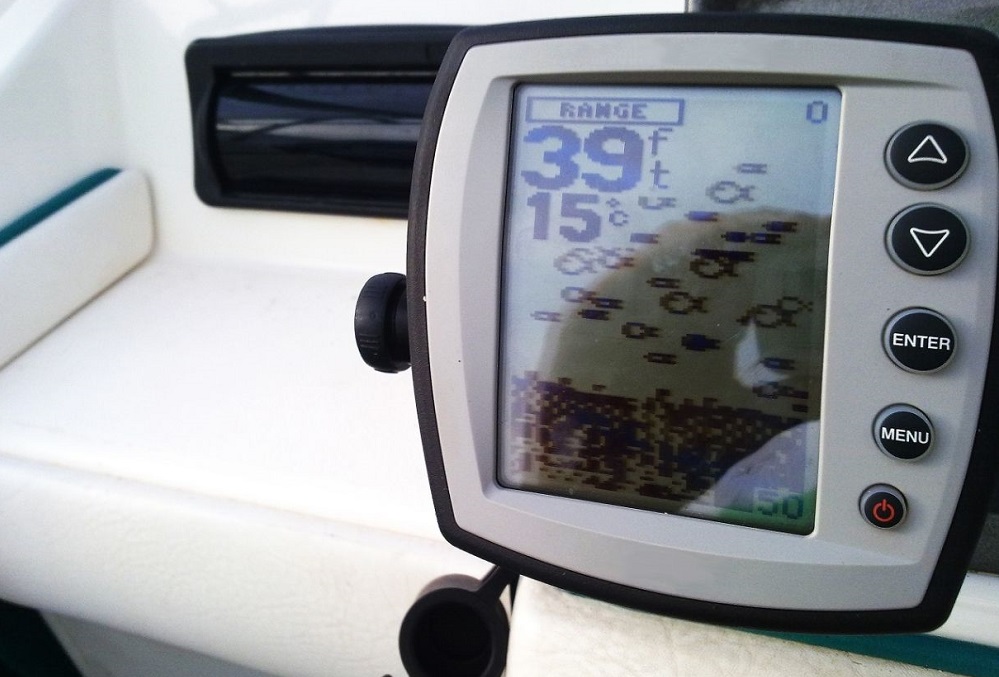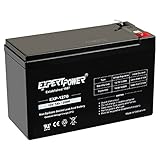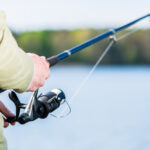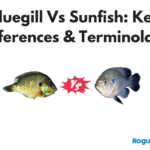The best fishing trips are the ones that take you out of the rat race long enough for you to catch some breath, take in some nature, and spend some quality hours on the water doing what you love. The only problem is our fish finder’s batteries don’t share our penchant for long stints off the grid, and once they run out, we’re fishing blind.
It’s not impossible to fish without one, but if you’re not from an area, local fisherfolk can be a little tightlipped about the best spots. When your battery runs dead, for all you know, you’re wasting time waiting for a bite in barren waters and risk returning home empty-handed, out of pocket, out of vacation days, and out of luck. But we’re not going to let that happen.
We’ve compiled a list of eight of the best fish finder batteries in 2022 that you can currently buy, so sit back, check out the reviews, and get ready to plan that next trip.
OUR TOP PICK
ExpertPower 12v 10AH Lithium Battery
[5stars]

This ExpertPower creation is the battery you’ve been dreaming of. Utilizing state-of-the-art lithium iron phosphate for the anode (the electrode through which current enters), these batteries last more than twice as long as their standard SLA counterparts,
A single charge will last three to four days, depending on the pull of your fish finder. That’s a full worry-free weekend on the water focusing on what’s important: your catch rate and enjoying your trip.
What’s more, it doesn’t just have a bigger charge life than equivalent SLAs; it has a longer service life period, lasting 2500 – 7000 charge cycles instead of the standard SLA life span of 200 to 500 cycles. That amounts to a minimum of 5 and a maximum of 35 times the typical SLA life span.
It’s also 70% lighter than traditional SLA batteries, bringing down your overall pack weight so that you can explore and fish for even longer. It’s a little pricey, but the battery management system protects it from charge damage, ensuring a long service life and that you get your money’s worth.
Pros
- 2500 – 7000 Charge Cycles – You won’t need to replace this battery for years.
- Lightweight – It’s not only lighter than SLA batteries but other lithium batteries too.
- 10AH – It will power most fish finders for a full long weekend trip.
Cons
- The Price Tag – This kind of power doesn’t come for free.
EDITORS CHOICE
Dakota Lithium 12v 10AH Lithium Battery
[5stars]

Hailing from the rugged terrain of North Dakota, this battery can roll with the punches. Designed specifically for use in challenging terrain, it’s one of the best batteries for your fish finder there is.
Powered on the same lithium iron technology as our top pick, this battery lasts for upward of 2000 charges, blowing traditional SLAs out of the water. It’s not quite as feather-light as our number one pick but still comes in at half the weight of normal batteries of equivalent power.
In addition, it charges five times faster than the competition, so you’ll never be hanging around waiting for a full charge again, which means more time on the water, more fish, and more fun.
Able to perform in temperatures as low as -20°F, you could even use this bad boy for some high-yield ice fishing in the dead of winter and keep up your fishing routine year-round.
Protected by BMS technology that controls cell balancing, voltage cut-off, and short-circuiting, and covered by a ‘best in industry’ 11-year warranty, the Dakota Lithium is a battery you can rely on come hell or high water.
Pros
- Rugged Design – This battery is durable enough to handle the rough and tumble of kayak fishing.
- Fast Charge – Charges faster than most other batteries.
- Well Insulated – You can use this battery in hot and cold temperatures.
Cons
- Expensive – It’s a lithium design, so it carries a premium price tag.
BEST VALUE
ExpertPower 1270 12v 7AH SLA Battery
[5stars]

The EXP 1270 may not be a super-charged lithium-iron monster like our top two picks, but as far as the SLA blueprint goes, it’s the best in the business, and you can snatch one up for a bargain too.
Historically, this was considered a quality power solution for home security systems, but PowerExpert tweaked the formula to prime it for marine activity.
The solid ABS enclosure contains glass mat separators and lead plates to prevent leaking and increase overall durability. Come splashes of saltwater, come rattling around a kayak, come temperature fluctuations, the 1270 can handle it.
The 7AH amp-hours rating means it’s probably best for half-day trips on the water, but it charges in as little as four hours, so you can be ready to get back out there in record time!
Pros
- Solid Construction – ABS enclosure is tough as nails.
- Price – Much more affordable than lithium batteries.
Cons
- 7AH – One charge won’t be suitable for long fishing trips.
RUNNER UP
Chrome Battery SLA 12v 7AH Lead Acid Battery
[4stars]

The CB SLA 12v 7AH is one of the most robust batteries on the market, making it a shoo-in for applications that stray from the beaten track.
Beneath the solid plastic exterior, you’ll find absorbed fiberglass mat technology that eliminates the chance of leaking and ensures this battery will never require maintenance of any kind.
The case itself is fitted using welding techniques, imbuing it with vibration and impact resistance, so it’ll handle a trip out powering your Garmin Striker or Humminbird Helix without breaking a sweat.
If you’re looking for a total workhorse but don’t have the budget to buy top-end, the CB SLA is durable, affordable, and can power the average fish finder for roughly 6 hours before it even drops from 100% charge.
Pros
- Solid Design – Vibration and impact resistance ensure it won’t let you down in the middle of an expedition.
- Price – Great battery if you’re on a budget.
Cons
- 7AH – You’ll definitely need to take a charger with you.
RUNNER UP
Mighty Max YTX20L-BS 12v 18AH Battery
[4stars]

Built using a state-of-the-art calcium-alloy grid, the MM YTX20L-BS has one of the longest service lives outside of lithium anode technology, so that this one-time fee will cover years of bounteous fishing trips.
Despite its compact, portable appearance, the high-quality AGM technology ensures a maintenance-free product that won’t leak, won’t suffer from overcharge, and ultimately won’t let you down.
A fish-finder mountable design, the 18AH capacity will power your whole fishing adventure through, no question about it. Our only caveat is that charge life does tend to deteriorate the more you use this battery, but there are ways to stave off this degradation.
If you set it to charge as soon as you hit the base and ensure the connector cables are nice and clean, you can minimize or even completely negate the slow-shrinking of the charge.
Pros
- Long Service Life – Considering this isn’t a lithium battery, it lasts an impressively long time.
- Portable – This battery won’t weigh you, your kayak, or your boat down.
Cons
- Deteriorating Charge Life – If not recharged immediately after use, it can lead to a reduced charge life.
RUNNER UP
Power-Sonic 12v 7AH 570 Portable Fish Finder Battery
[4stars]

Although it can be used for many applications, the PS 570 was designed exclusively for powering fish finders, making this an easy choice for many anglers looking for some sonar power to increase their catch rates.
Featuring AGM technology, the 570 doesn’t get seasick no matter how choppy the water gets. It’s 100% spillproof! Finding particular notoriety amongst kayak fishing enthusiasts due to its portability, finder-optimized compatibility, and shock absorbent enclosure, it could well be the perfect battery for you.
It’s only a 12v 7AH design, but considering most fish finders often draw less than one amp per hour, you can stay out on the water as long as you want, and the PS 570 will keep your fish finder going strong.
Pros
- Compatibility – Fish finder optimized design.
- Portability – Nice compact design opens up some space on the water.
Cons
- 7AH – Will probably need charging at least once throughout a long fishing trip.
RUNNER UP
Universal Power Group UB12350 12v 35AH SLA Internal Thread Battery
[4stars]

You may be thinking that our penultimate pick is way too overpowered for the humble fish finder, but that’s because it’s found common use as a multi-purpose battery. Some innovative anglers are known to use the UPG SLA for powering both their motor-drive kayaks and their fish finders simultaneously, reducing pack size, and freeing up space on the water.
It’s not just pure brawn, though. The UB12350 is actually an incredibly articulate tool. Featuring absorbent AGM technology and valve-regulated construction, it requires zero maintenance and will never leak. Moreover, the casing is reinforced to withstand impacts and resist vibration, so it doesn’t matter when things get a little rocky out on the waves.
It’s capable of powering all kayak electronics and will even be able to power a small boat on a single charge, whether you’re only out for a few hours or from dawn till dusk every day for a whole weekend.
Pros
- Powerful Battery – The UPG UB12350 can be used for your motor and your fish finder.
- Maintenance-Free – This battery won’t need any TLC.
Cons
- Interference – Multi-use batteries are more likely to cause transducer interference.
RUNNER UP
Mighty Max 12V 8AH SLA Battery
[4stars]

If you’re looking for a relatively easy-going budget battery with enough power to keep your finder findin’ for a couple of days of fishing, the MM 12v 8AH SLA should be a serious consideration for you.
Available for less than $20, it does everything you need to do and still features some pretty advanced appointments such as AGM absorption to prevent leaking and quality insulation to expand operating temperatures.
It even features deep discharge recovery technology, so if you accidentally stay out too long and fully drain the juice, a charger will be able to shock it back into action.
Be mindful that some users found the connectors to be a little bit weak, but those are relatively isolated situations, and if a connector does break, it comes with a one-year warranty.
Pros
- Price – Most affordable battery on our list.
- Discharge Recovery – Can be reinvigorated after running below 20%.
Cons
- Weak Connectors – Some claim the connectors felt a little fragile.
Best Battery for Fish Finder Buying Guide
We know you’re itching to get out into the water, but before you settle on a new battery for your fish finder, you’ll need to think about a few key things.

Power Requirements
Most fish finders offer optimal performance when powered by a 12v power source. Incompatible pairings can damage both the battery and your fish finder, so you must choose the correct voltage.
Next, you should try and determine what you and your fish finder require of a battery. How much energy does your fish finder eat up to keep you in the know, and how long do you like to be out on the water?
To figure out how long a battery will last, you need to acquire two bits of information.
- The pull of your fish finder in amps – You should be able to find this on the unit itself, the packaging, or the manual. Failing that, check the manufacturer’s website.
- The amp-hours (AH) of the prospective battery – This should be a prominent fixture in the battery name or at the very least printed on the casing. Once again, if you’re not sure, check the manufacturer’s website.
You’re then left with a little bit of maths, but don’t worry; it’s a simple sum. All you have to do is….AH of Battery…Divided By…Draw (Amps) of Fish Finder = Capacity (Charge Life)
Let’s use a popular fish finder as an example to elucidate what we mean. The Garmin Striker 4 is designed to run on a 12v load and pulls 0.23 amps. Say we are considering a 12AH battery; 12 divided by 0.23 = just over 52 hours of use.
Of course, this only considers the battery’s theoretical performance, which is always much more impressive than real-life performance. It doesn’t account for environmental variables such as ambient temperature and production variables such as the differing quality of components. In light of this, it’s advisable to opt for a battery with a 20% larger AH rating than the sum states.
For fish finders or other electronics such as light strips in kayaks, we recommend never buying a battery with an AH rating of less than 7.
Types of Battery for Fish Finders
Now let’s discuss the battery types you should be considering. Though there are many kinds of batteries, only two meet the power, safety, and environmental requirements.
Lithium – LIFePO4
The first thing you’ll notice about lithium batteries is the price tag, but don’t let that scare you off because they’re quite good value-for-money products. Generally thought of as the best power source for fish finders, lithium batteries…
- Last two to three times as long as SLA batteries
- Weigh between 50 and 70% less
- Tend to be more compact
- Can distribute 100% of their charge without incurring damage
Sealed Lead Acid – SLA
SLA batteries are often used for multi-purpose marine applications because…
- They’re affordable
- Their sealed enclosure and internal AGM (absorbed glass mat) technology prevent leaking.
- They perform well regardless of orientation.
They also happen to be quite large and heavy, which can be a problem when you have limited space in a kayak or small boat. In addition, you need to be careful to keep around 20% of their power intact at all times as complete discharge can damage their functionality.
Portability
As fishing often requires a fair amount of trekking or travel in small kayaks or boats, the dimensions and weight of a battery should play a big role in your decision-making process.
A few extra pounds may seem negligible, but when you’re oaring it around all day, you’ll feel it in your shoulders. In addition, most kayaks simply don’t have the space to accommodate all your gear as well as a heft battery, so shopping around for something that arrives at an appropriate intersection between power and portability is key.
As mentioned earlier, lithium batteries are generally the lighter, more space-kind option, but the price tag is too steep for many. However, do try to remember that you’ll go through far more SLA batteries in your fishing career than lithium batteries.
Charging Time
We’ve all been there. You’re up nice and early, your pack’s locked and loaded, you’re ready to set out on an epic fishing adventure, but you realize you’ve forgotten to charge your battery overnight.
If you’ve got a battery with a long charging period, your plans are pretty much ruined, but if you’ve got one that completes in, say, 4 hours, you can still head out and enjoy most of the day.
Battery Storage – Some Words of Advice
A battery box isn’t an essential bit of gear, especially if you only fish once in a blue moon, but if you’re out there every spare bit of time you get, you should seriously consider adding one to your setup.
They prevent damage from impact, vibration, water, dust…a battery is safer in just about every possible way when kept in one of these boxes. If you’ve invested in a quality lithium battery, it makes even more sense to secure it onboard when you take it to the water.
A Note on Charging – Don’t Make This Rookie Mistake
If your battery doesn’t come with a charger, you need to make sure that the one you buy is compatible. If you attempt to charge a lithium battery with an SLA charger, it won’t charge properly in the best-case scenario. In the worst, it will degrade the electrolyte and take a significant amount off its service life.
Frequently Asked Questions
Do I Need a Separate Battery for My Fish Finder?
You don’t necessarily need a separate battery for your fish finder, or the best ice fishing flashers, as long as the starter battery has enough power to spare and is compatible with your finder; however, there are a few benefits to using a dedicated battery.
Firstly, you won’t experience sudden voltage fluctuations due to your motor. Secondly, it reduces the chance of electrical interference.
How Long Will a Fish Finder Battery Last?
It depends entirely on the fish finder and battery in question. You can estimate how long a battery will last by dividing the battery’s AH (amp hours) by the draw (amps) of the fish finder. This should give you a rough idea of charge life, but it’s only theoretical.
Batteries never power as long as they’re theoretically capable, so it makes sense to buy a battery with a higher than minimum AH rating for your trip.
What Kind of Battery Do I Need for My Fish Finder?
To find out what battery is compatible with your fish finder, you’ll need to determine how many volts it requires to function. Most fish finders are 12v devices, but some more advanced models with built-in GPS may require 24v.
Next, you’ll need to choose between lithium and SLA battery types. Lithium batteries are lighter and last longer, but they’re quite expensive. SLA batteries are very affordable but are heavy and lack the longevity of their lithium counterparts.
Finally, you’ll need to decide how long you expect each fishing session to last and settle on an AH (amp hours) rating accordingly. 7 – 10AH batteries are good for short to mid-length trips, while 12 – 18AH batteries are preferable for longer stints on the water.
Can you Use a Lawn Mower Battery with a Fish Finder?
In some cases, yes, but it’s important to ensure that the battery is fully compatible with your fish finder and durable enough to handle the rigors of a fishing trip, as broken batteries pose a health and environmental risk.
Final Thoughts
There’s nothing worse than your fishing finder running out of power mid-trip, but now you’re clued up on the best batteries for fish finders, you’ll never have to be in that situation ever again.
After deciding between a lithium and SLA battery type, all you have to do is check your fish finder’s capacities and ponder how long you want to be in the water. It’s as simple as that. Once that’s sorted, you’ll be casting out in no time at all.








